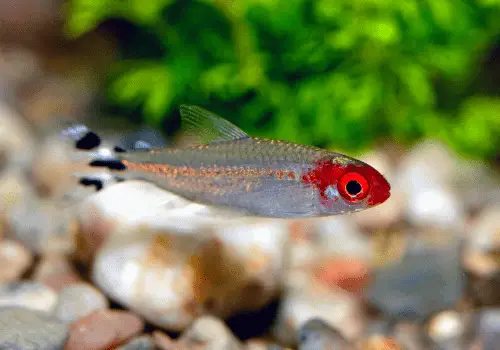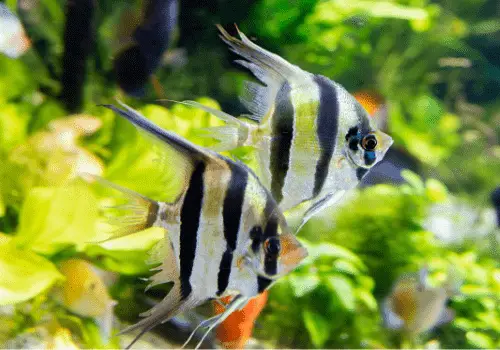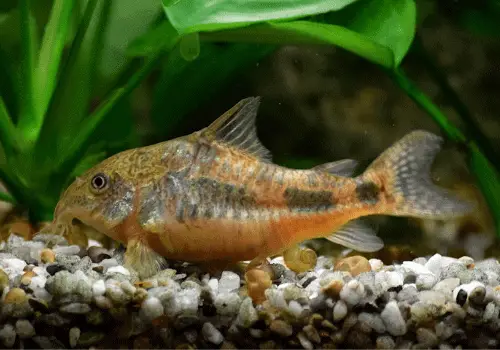There are so many different fish types, some you may have heard of and some you most likely won’t have. Some fish actually have multiple common names, so you may find that your favorite fish type has another name you’ve never heard before! One of the best ways to identify fish is by their scientific names, also known as their Latin names. The reason for this is because, since Latin is a “dead” language, these names do not change and are known around the world by people of all languages.
We’ve included the scientific names of all of our fish that start with A in brackets next to their common fish names – just in case you wanted to impress your pals with your extensive fish knowledge! Knowing the scientific name means that you’ll definitely get the correct breed when you go to buy one, as many common names cover a huge variety. For example, angelfish are available in varieties that live in freshwater and some that live in salt water, and you don’t want to mix that up!
Table of Contents
Our Top 5 Fish Names Beginning with Letter A
We’ve chosen a few of our favorite fish beginning with A that we’re sure you’ll love just as much as we do. So here we are to tell you a little more about them.
African Blockhead Cichlid (Steatocranus casuarius)
This freshwater fish is also known as a Lionhead cichlid – this fish’s distinguishing feature is the lump on the top of its head. The scientific name Steatocranus comes from the Greek words steatos1 and kranion2 which mean hard fat1 and skull2, describing perfectly this cichlid’s bumpy bonce. African Blockhead cichlids predominantly live in fast-moving waters and don’t tend to swim about all that much when in an aquarium, when they do, it is a short burst usually followed by a bit of perching on a rock. This breed of cichlid is pretty easy to keep and can be kept in a community tank and are pretty easy to look after – a great option for a cichlid newbie.
Ahl’s Rummy Nose Tetra (Hemigrammus bleheri)

These little red-nosed cuties are found wild in South America, where they live in blackwater rivers and streams and travel in shoals. If you want to keep rummy nose tetra, then it is important to have at least 5, just so they don’t get lonely. These gentle fish don’t like confrontation, so only pair them with other peaceful fish as tank mates. Ahl’s Rummy Nose tetra like soft water which is a slightly acidic 6-7 pH and like to eat good quality flaked food as well as live or frozen.
Angelfish (Pterophyllum altum)

Despite being a variety of cichlid (who are known for being bad-tempered) these fish live up to their angelic name. The only time when an Angelfish might show its cichlid tendencies are when they are breeding, as they become very territorial. Angelfish can be kept together and they will actually spawn quite regularly when mixed together – just be ready for some of those eggs to become fish food. Tankmates can be placed with Angelfish, but they are known to actively hunt smaller fish, so choose carefully. Also, because these cichlids can’t swim as quickly as others, they could get bullied by other faster fish, like fin-nipping barbs.
Asian Arowana (Scleropages formosus)
Also known as dragonfish, these Southeast Asian fish are found in blackwater rivers and areas of slow-moving water, like swamps and wetlands. They actually do resemble a traditional Chinese dragon due to their large scales which has given them their own cultural significance in areas influenced by Chinese culture – they are considered good luck charms. Arowana grow quite large and can reach up to around 35 inches and the adults feed on other fish (while infants feed on insects). Sadly, in 2006 Arowanas were added to the endangered species list, so are now predominantly found in conservation.
Axelrod’s Corydoras (Corydoras axelrodi)

There are many varieties of corydoras, all of which make great tank mates for a variety of freshwater fish. These little fish hail from Colombia where they live inland, in rivers and they feed on plant material, insects, worms and even small crustaceans. These bottom-feeder’s favorite aquarium conditions would be with a fine sand substrate and somewhere covered – corydoras like to hide from time to time, so live plants, wood or rocks are a great addition to your tank.
List of fish names starting with A
Check out even more fish whose names start with A below. We’ve separated the freshwater fish and saltwater fish so you can read up on the ones that suit your aquarium plans the most. If you’ve got eagle eyes and can’t spot the name of your favorite fish beginning with A, let us know in the comments so we can keep our list as extensive as possible!
Freshwater fish starting with A:
- Aba Aba (Gymnarchus niloticus)
- Ablabes Barb (Barbus ablabes)
- Abrau Sprat (Clupeonella abrau)
- Adolfo’s Cory (Corydoras adolfoi)
- Adonis Characin (Lepidarchus adonis signifer)
- Adonis Pleco (Acanthicus adonis)
- Adonis Tetra (Lepidarchus adonis)
- African Brass Tetra (Brycinus humilis)
- African Broad-Band Darter (Nannocharax parvus)
- African Butterfly Cichlid (Anomalochromis thomasi)
- African Glass Catfish (Pareutropius buffei)
- African Knifefish (Xenomystus nigri)
- African Lungfish (Protopterus annectens)
- African Moon Tetra (Bathyaethiops caudomaculatus)
- African Peacock Cichlid (Aulonocara nyassae)
- African Pike-Characoid (Hepsetus odoe)
- African Red-Eyed Characin (Arnoldichthys spilopterous)
- African Tiger Fish (Hydrocynus goliath)
- African Whiptail Catfish (Phactura ansorgii)
- African Wood Catfish (Chrysichthys ornatus)
- Agassiz’s Dwarf Cichlid (Apistogramma agassizii)
- Aholehole (Kuhlia sandvicensis)
- Airbreathing Catfish (Clarias batrachus)
- Airsac Catfish (Heteropneustes fossilis)
- Akure Aphyosemion (Fundulopanchax gardneri)
- Alabama Hog Sucker (Hypentelium etowanum)
- Alaska Blackfish (Dallia pectoralis)
- Albert’s Synodontis (Synodontis alberti)
- Albino Driftwood Cat (Auchenipterus nuchalis)
- Albino Fetivum (Mesonauta festiva)
- Albino Tiger Barb (Barbus tetrazona)
- Algae Eater, False Siamese (Epalzeorhynchos sp)
- Algae Eater, Lemon (Gyrinocheilus aymonieri)
- Algae Eater, Siamese (Crossocheilus siamensis)
- Alligator Gar (Atractosteus spatula)
- Altum Angel (Pterophyllum altum)
- American Flagfish (Jordanella floridae)
- Amur Catfish (Pelteobagrus fulvidraco)
- Amur Pike (Esox reichertti)
- Angelicus (Synodontis angelicus)
- Angler Catfish (Chaca bankanensis)
- Anostomus (Anostomus anostomus)
- Ansorge’s Neolebias (Neolebias ansorgii)
- Apollo Shark (Luciosoma trinema)
- Arapaima (Arapaima gigas)
- Arched Corydoras (Corydoras arcuatus)
- Archer Eelpout (Lycodes sagittarius)
- Archerfish (Banded)(Toxotes jaculatrix)
- Archerfish (Common)(Toxotes chatareus)
- Arctic char (Salvelinus alpinus)
- Armor Bill Tetra (Phago loricatus)
- Armored Catfish (Callichthys callichthys)
- Armoured Bichir (Polypterus delhezi)
- Arowana (Osteoglossum bicirrhosum)
- Arulius Barb (Puntius arulius)
- Asian Arowana (Scleropages formosus)
- Asian Bumblebee Catfish (Leiocassis siamensis)
- Asian Carps (Cyprinus carpio)
- Asian Redtailed Catfish (Hemibagrus wyckioides)
- Asiatic Glassfish (Parambassis ranga)
- Asiatic Knifefish (Notopterus notopterus)
- Auratus (Melanochromis auratus)
- Aurora Cichlid (Pseudotropheus aurora)
- Australian Bass (Macquaria novemaculeata)
- Australian Grayling (Prototroctes maraena)
- Australian Herring (Arripis georgianus)
- Australian Lungfish (Neoceratodus forsteri)
- Australian Pearl Arowana (Scleropages jardini)
- Australian Rainbowfish (Melanotaenia fluviatilis)
- Australian Spotted Arowana (Scleropages leichardti)
- Australian Swamp Eel (Ophisternon gutturale)
- Axelrod’s Rainbowfish (Chilatherina axelrodi)
- Azureus Cichlid (Copadichromis azureus)
Saltwater fish starting with A:
- Abbott’s Moray Eel (Gymnothorax eurostus)
- Abrolhos Jawfish (Opistognathus alleni)
- Albacore (Thunnus alalunga)
- Alewife (Alosa pseudoharengus)
- Alfonsino (Beryx decadactylus)
- Alligatorfish (Aspidophoroides monopterygius)
- Amberjack (Seriola dumerili)
- American Sole (Achirus lineatus)
- Anchovy (Engraulis encrasicolus)
- Anemonefish (Amphiprion ocellaris)
- Angelfish (Pomacanthus paru)
- Angler (Lophius piscatorius)
- Anglerfish (Melanocetus johnsonii)
- Antarctic Cod (Dissostichus mawsoni)
- Antarctic Icefish (Notothenioidei)
- Antenna Codlet (Bregmaceros atlanticus)
- Armored Searobin (Peristedion gracile)
- Armorhead (Zanclistius elevatus)
- Arrowtooth Eel (Histiobranchus bathybius)
- Atka Mackerel (Pleurogrammus monopterygius)
- Atlantic Bonito (Sarda sarda)
- Atlantic Cod (Gadus morhua)
- Atlantic Herring (Clupea harengus)
- Atlantic Mudskipper (Periophthalmus barbarus)
- Atlantic Salmon (Salmo salar)
- Atlantic Saury (Scomberesox saurus)
- Atlantic Sharpnose Shark (Rhizoprioltodon terraenovae)
- Atlantic Silverside (Menidia menidia)
- Atlantic Sturgeon (Acipenser sturio)
- Australasian Salmon (Arripis trutta)
- Australian Prowfish (Pataecus fronto)
- Ayu (Plecoglossus altivelis)
